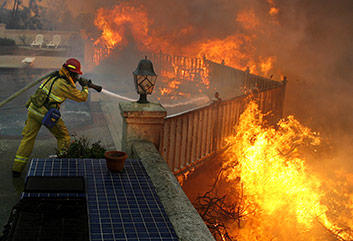Reducing Impact of Wildland-Urban Interface Fires
Fires within communities surrounded by natural areas are the most dangerous and costliest fires in North America. Growing at a staggering 4,000 acres per day, these Wildland-Urban Interface (WUI) communities are rapidly becoming the nation’s single largest fire concern. NIST-led research and post-fire investigations are providing the scientific basis for reducing a WUI community’s fire risk.

NIST researchers are using a century of technical experience studying fires to reduce the impact of fires on WUI communities. NIST discovered that WUI fires spread in a different way from other urban fires, and is leading the research to limit the spread and damage from WUI fires.
Colorado's devastating 2012 Waldo Canyon wildfire burned for 17 days, killing two and costing $500 million in losses. A NIST report from a post-fire, on-site investigation detailed the timeline of fire movement and fire responder actions. NIST’s report provides technical recommendations that are improving communities’ resilience to wildfires. NIST investigations of WUI fires revealed that they mainly spread through wind-blown embers rather than direct flame propagation. This finding changed how the fire community thinks about WUI fires.
To help study WUI fires, NIST researchers developed a full-scale ember generator, known as the NIST Dragon. The Dragon creates a continuous flow of flying embers that mimic those from actual WUI fires, enabling experiments that can help researchers understand how to better characterize ember ignition. The Dragon has been duplicated by the U.S. insurance industry and wildland fire research labs in Portugal and Japan. Results from the Dragon tests are being incorporated into building codes around the world (e.g., use of new ember-resistant roofs and attic vents), and guiding firefighters and communities in developing WUI fire prevention and mitigation strategies (e.g., increased distances between homes and landscaping).
37+
technical findings and 13 technical recommendations for improving community resilience to wildfires
“The vision and fundamental work by NIST to develop the capability to generate firebrands in the laboratory (has) laid the foundations for … advancing our understanding of vulnerabilities and mitigation strategies for buildings threatened by wildfire.”
– Stephen L. Quarles Chief Scientist for Wildfire and Durability, Insurance Institute for Business & Home Safety

